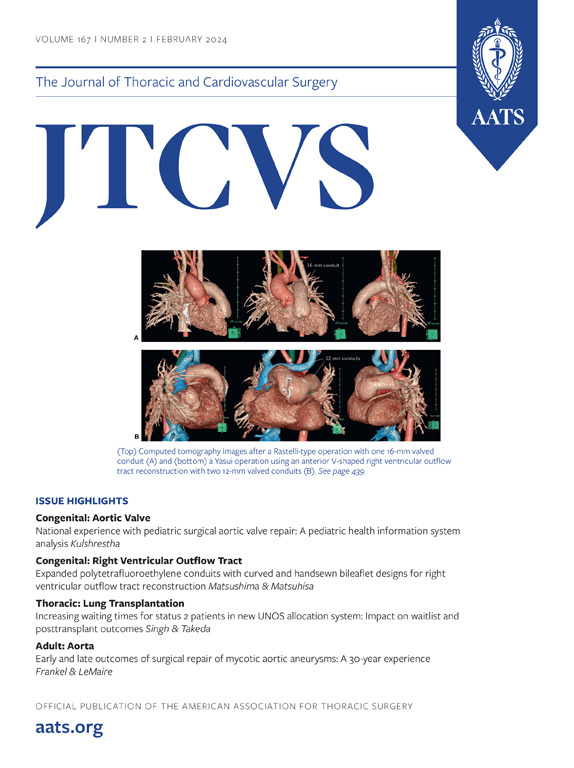Volume-failure-to-rescue relationship in acute type A aortic dissections: An analysis of The Society of Thoracic Surgeons Database
IF 4.9
1区 医学
Q1 CARDIAC & CARDIOVASCULAR SYSTEMS
Journal of Thoracic and Cardiovascular Surgery
Pub Date : 2024-11-01
DOI:10.1016/j.jtcvs.2023.08.037
引用次数: 0
Abstract
Objective
To determine the relationship between volume of cases and failure-to-rescue (FTR) rate after surgery for acute type A aortic dissection (ATAAD) across the United States.
Methods
The Society of Thoracic Surgeons adult cardiac surgery database was used to review outcomes of surgery after ATAAD between June 2017 and December 2021. Mixed-effect models and restricted cubic splines were used to determine the risk-adjusted relationships between ATAAD average volume and FTR rate. FTR calculation was based on deaths associated with the following complications: venous thromboembolism/deep venous thrombosis, stroke, renal failure, mechanical ventilation >48 hours, sepsis, gastrointestinal complications, cardiopulmonary resuscitation, and unplanned reoperation.
Results
In total, 18,192 patients underwent surgery for ATAAD in 832 centers. The included hospitals' median volume was 2.2 cases/year (interquartile range [IQR], 0.9-5.8). Quartiles’ distribution was 615 centers in the first (1.3 cases/year, IQR, 0.4-2.9); 123 centers in the second (8 cases/year, IQR, 6.7-10.2); 66 centers in the third (15.6 cases/year, IQR, 14.2-18); and 28 centers in the fourth quartile (29.3 cases/year, IQR, 28.8-46.0). Fourth-quartile hospitals performed more extensive procedures. Overall complication, mortality, and FTR rates were 52.6%, 14.2%, and 21.7%, respectively. Risk-adjusted analysis demonstrated increased odds of FTR when the average volume was fewer than 10 cases per year.
Conclusions
Although high-volume centers performed more complex procedures than low-volume centers, their operative mortality was lower, perhaps reflecting their ability to rescue patients and mitigate complications. An average of fewer than 10 cases per year at an institution is associated with increased odds of failure to rescue patients after ATAAD repair.
急性A型主动脉夹层体积衰竭与抢救的关系:胸外科医师学会数据库分析。
目的:确定美国急性A型主动脉夹层(ATAAD)术后病例数与抢救失败率(FTR)之间的关系。混合效应模型和限制三次样条用于确定ATAAD平均体积和FTR率之间的风险调整关系。FTR的计算基于与以下并发症相关的死亡:静脉血栓栓塞/深静脉血栓形成、中风、肾衰竭、机械通气>48小时、败血症、胃肠道并发症、心肺复苏和计划外再次手术。结果:832个中心共有18192名患者接受了ATAAD手术。纳入医院的中位容量为2.2例/年(四分位间距[IQR],0.9-5.8)。第一个四分位的分布为615个中心(1.3例/年,IQR,0.4-2.9);第二组123个中心(8例/年,IQR,6.7-10.2);第三组66个中心(15.6例/年,IQR,14.2-18);第四分位数有28个中心(29.3例/年,IQR,28.8-46.0)。第四分位医院进行了更广泛的手术。总并发症、死亡率和FTR率分别为52.6%、14.2%和21.7%。风险调整分析表明,当平均每年病例数少于10例时,FTR的几率增加。结论:尽管高容量中心比低容量中心进行更复杂的手术,但它们的手术死亡率较低,这可能反映了它们抢救患者和减轻并发症的能力。一家机构平均每年少于10例病例与ATAAD修复后患者抢救失败的几率增加有关。
本文章由计算机程序翻译,如有差异,请以英文原文为准。
求助全文
约1分钟内获得全文
求助全文
来源期刊
CiteScore
11.20
自引率
10.00%
发文量
1079
审稿时长
68 days
期刊介绍:
The Journal of Thoracic and Cardiovascular Surgery presents original, peer-reviewed articles on diseases of the heart, great vessels, lungs and thorax with emphasis on surgical interventions. An official publication of The American Association for Thoracic Surgery and The Western Thoracic Surgical Association, the Journal focuses on techniques and developments in acquired cardiac surgery, congenital cardiac repair, thoracic procedures, heart and lung transplantation, mechanical circulatory support and other procedures.

 求助内容:
求助内容: 应助结果提醒方式:
应助结果提醒方式:


